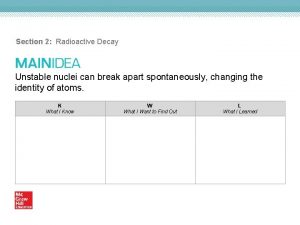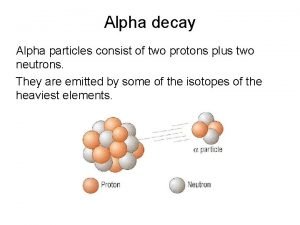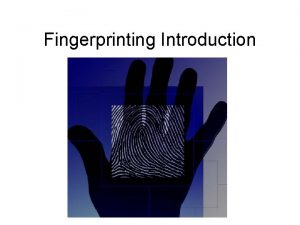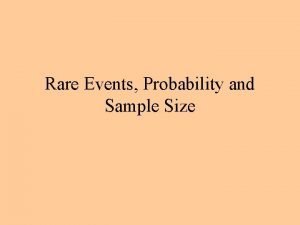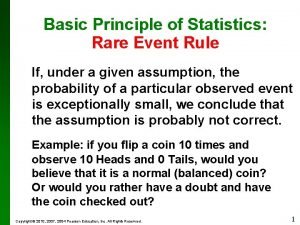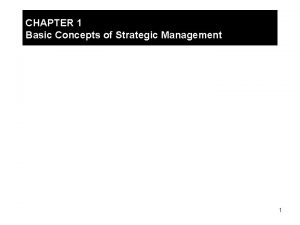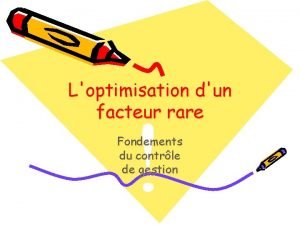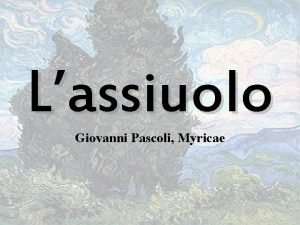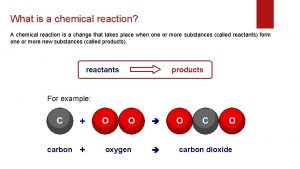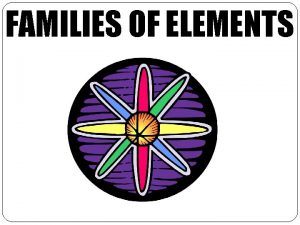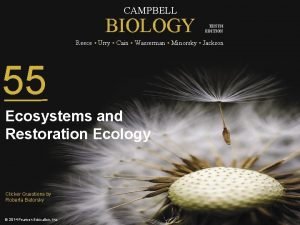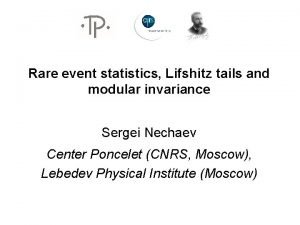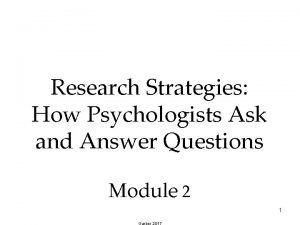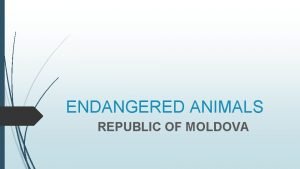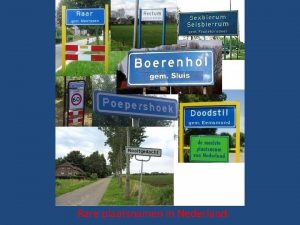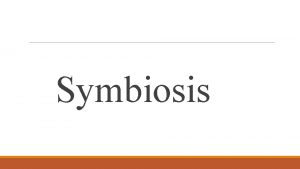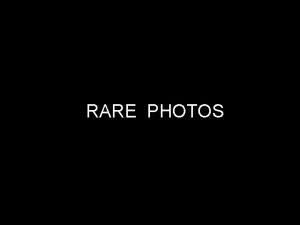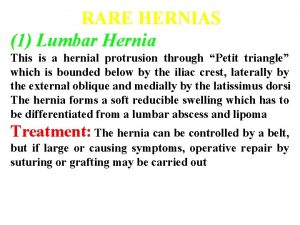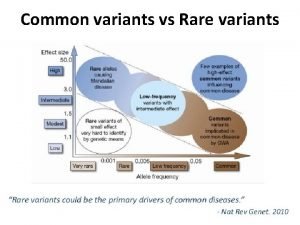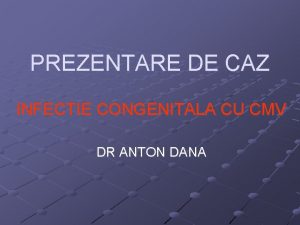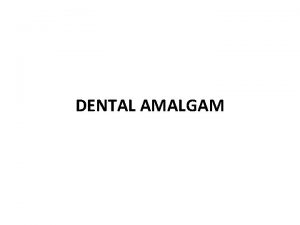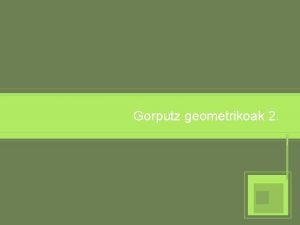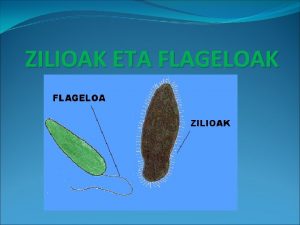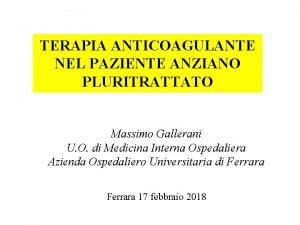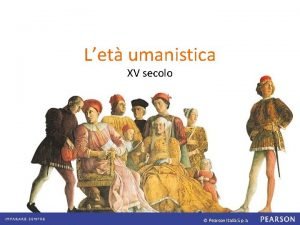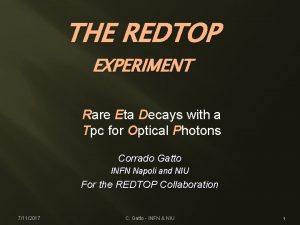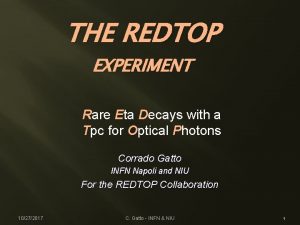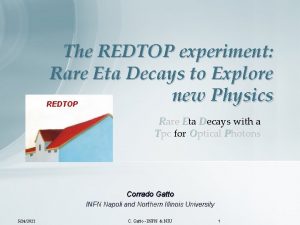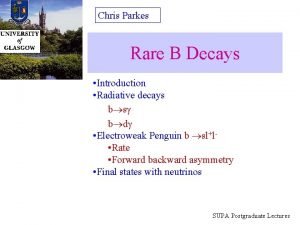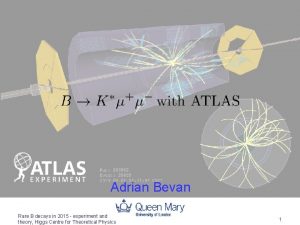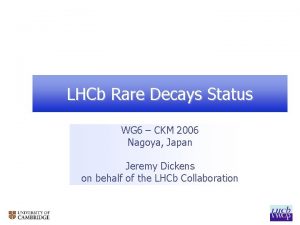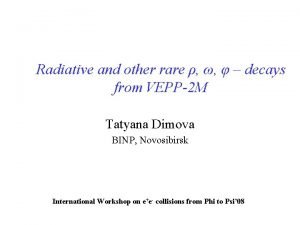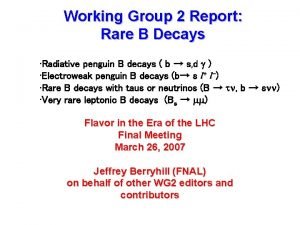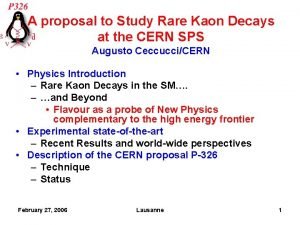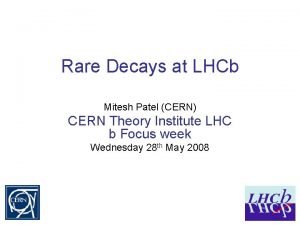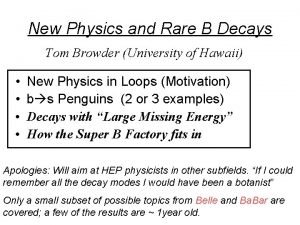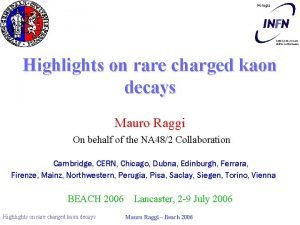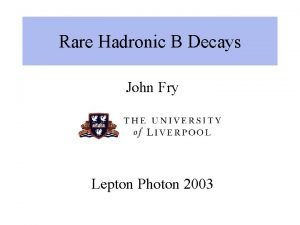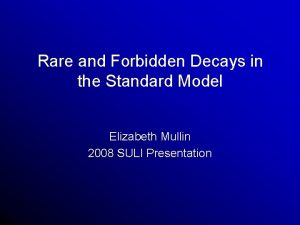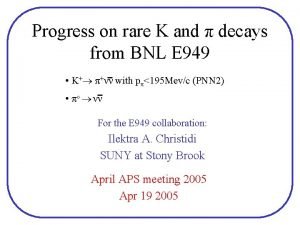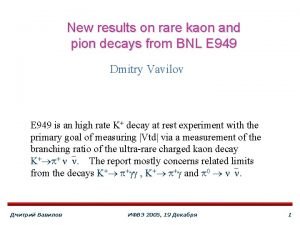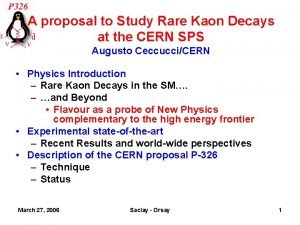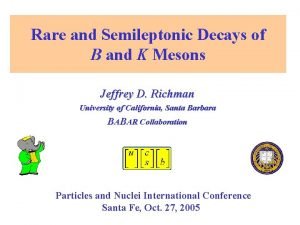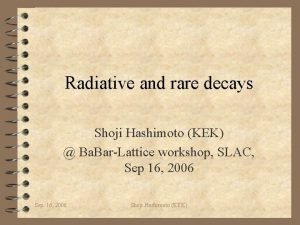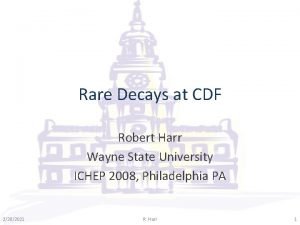REDTOP EXPERIMENT STATUS UPDATE Rare Eta Decays with









































- Slides: 41

REDTOP EXPERIMENT: STATUS UPDATE Rare Eta Decays with a Tpc for Optical Photons Corrado Gatto INFN Napoli and Northern Illinois University For the REDTOP Collaboration 4/3/2019 C. Gatto - INFN & NIU 1

The Physics Landscape for REDTOP SM is showing its age SM matter: Dark energy=5%: 25%: 70% Baryon Asymmetry of the Universe Expansion of the universe is accelerating (hint to more forces) . . New physics is elusive: probability of processes where new physics is coupled to SM physics is low LHC found no hint of new physics at high energy so far Newest theoretical models prefer gauge bosons in Me. V-Ge. V mass range as “…many of the more severe astrophysical and cosmological constraints that apply to lighter states are weakened or eliminated, while those from high energy colliders are often inapplicable” (B. Batell , M. Pospelov, A. Ritz – 2009) High intensity-low energy experiments are growing in popularity (Fixed target and beam dump) 4/3/2019 C. Gatto - INFN & NIU 2

Why the h meson is special? It is a Goldstone boson Symmetry constrains its QCD dynamics It is an eigenstate of the C, P, CP and G operators (very rare in nature): IG JPC =0+ 0 -+ It can be used to test C and CP invariance. All its additive quantum numbers are zero Q=I=j=S=B=L= 0 All its possible strong decays are forbidden in lowest order by P and CP invariance, G-parity conservation and isospin and charge symmetry invariance. EM decays are forbidden in lowest order by C invariance and angular momentum conservation The η decays are flavor-conserving reactions Its decays are not influenced by a change of flavor (as in K decays) and violations are “pure” It is a very narrow state (Gh=1. 3 Ke. V vs Gr=149 Me. V) Contributions from higher orders are enhanced by a factor of ~100, 000 Excellent for testing invariances Decays are free of SM backgrounds for new physics search h is an excellent laboratory to search for physics Beyond Standard 4/3/2019 C. Gatto. Model - INFN & NIU 3

Detecting BSM Physics with REDTOP (h/h’ factory) Assume a yield 2. 5 x 1013 h mesons/yr and 2 x 1011 h’ mesons/yr C, T, CP-violation q q q q po CP Violation via Dalitz plot mirror asymmetry: asymmetry h → p p CP Violation (Type I – P and T odd , C even): h-> 4 po → 8 g CP Violation (Type II - C and T odd , P even): even h → po l+l and h → 3 g Test of CP invariance via m longitudinal polarization: h → m+m – Test of CP invariance via g* polarization studies: h → p+p –e+e – and h → p+p –m+m – Test of CP invariance in angular correlation studies: h → m+m – e+ e – Test of T invariance via m transverse polarization: h → pom+m – and h → g m+m – CPT violation: m polariz. in h → p+m-n vs h → p-m+n and g polarization in h → g g + - New particles and forces searches meson searches (charged channel): h → po H with H→e e+e- and H→m+mq Dark photon searches: h → g A’ with A’ → l+lq Protophobic fifth force searches : h → g X 17 with X 17 → e+e q Scalar - leptophobic baryonic force searches : h → g B with B→ e+e- or B→ g po q Indirect searches for dark photons new gauge bosons and leptoquark: h → m+m- and h → e+eq Search for true muonium: h → g (m+m – )|2 M → g e+e – m q New Other discrete symmetry violations q q Lepton Flavor Violation: h → m+e – + c. c. Double lepton Flavor Violation: h → m+m+e – + c. c. Non-h/h’ based BSM Physics q q Dark photon and ALP searches in Drell-Yan processes: qqbar → A’/a → l+l– ALP’s searches in Primakoff processes: p Z → p Z a → l +l – (F. Kahlhoefer) Charged pion and kaon decays: p+ → m+n A’ → m+n e+e– and K+ → m+n A’ → m+n e+e– Neutral pion decay: po → g. A’ → ge+e– 4/3/2019 Other Precision Physics measurements q Proton q All radius anomaly: h → g m+m – vs h → g e+e- unseen leptonic decay mode of h / h ‘ (SM predicts 10 -6 - High precision studies on medium energy physics q Nuclear models 10 -9) q Chiral perturbation theory q Non-perturbative q Isospin breaking due to the u-d quark mass difference q Octet-singlet mixing angle q Electromagnetic C. Gatto - INFN-2) & NIU QCD transition form-factors (important input for g 4

Optical TPC ~ 1 m x 1. 5 m CH 4 @ 1 Atm 5 x 105 Sipm/Lappd 98% coverage REDTOP detector • Scint. + heavy glass sandwich • 20 X 0 ( ~ 64 cm deep) • Triple-readout +PFA • 96% coverage m-polarizer Active version (from TREK exp. ) - optional 2. 4 m 10 x Be or Li targets • • 0. 33 mm thin Spaced 10 cm 1. 5 m 2. 7 m 1 m • • ADRIANO 2 Calorimeter (tiles) Fiber tracker for rejection of g-conversion and vertexing 11/17/2017 Aerogel Dual refractive index system C. Gatto - INFN & NIU OTPC 5

Recent History of the Project q q q Sept. 2017 q LOI submitted to Fermilab’s PAC in Sept. 2017 q PAC recommendation: “The PAC finds that the science goals of the experiment are very interesting…. . , the PAC does not recommend that the Laboratory invest resources into furthering the REDTOP proposal at this time. ” q Fermilab’s Director recommended a two-year waiting period (still ongoing). Jan. 2018 q REDTOP admitted into the “Physics Beyond Colliders” program to explore a possible implementation at CERN q Near full simulations studies indicate very good sensitivity studies to physics BSM for 3 out of 4 “portals” q Final report from PBC indicate that the experiment is feasible at CERN, but with lower (1/10 x) beam luminosity and larger impact on existing physics program cfr. FNAL Dec. 2018 q 4/3/2019 EOI submitted to European Strategy for Particle Physics C. Gatto - INFN & NIU 6

Summary of PBC Studies for 1017 POT (CERN) Dark photon searches Dark higgs searches ALPs with gluon coupling searches ALPs with fermion coupling searches 4/3/2019 C. Gatto - INFN & NIU 7

CP Violation from Dalitz plot mirror asymmetry in h-> p+p-po q q 4/16/2019 CP-violation from this process is not bounded by EDM as is the case for the η→ 4π process. Complementary to EDM searches even in the case of T and P odd observables, since the flavor structure of the eta is different from the nucleus Current PDG limits consistent with no asymmetry REDTOP will collect 4 x 1011 such decay (factor 100 in stat. error) R. Rusack - UMN 8

Status of the collaboration q Potential hosting laboratories: BNL, CERN, FNAL (either DR or PIP-II) 4/3/2019 C. Gatto - INFN & NIU 9

Ongoing activities - simulations Event generation Genie. Had (Genie add-on) event generator interfaces to: Urqmd, Gibuu, Phsd, Abla, Gemini, SMM, G 4 EM processes, Incl++, IAEA tables, LELAPS New interfaces to JAM (JPARC) and ALPS (for PIP-II simulations) in preparation Simulation, digitization, reconstruction and analysis Based on ILC frameworks (slic, lcsim and ilcroot) Full simulation in place (except for OTPC-reco and vertexing) Detector optimization and sensitivity studies are ongoing 4/3/2019 Improvement on BSM physics from detached vertices C. Gatto - INFN & NIU 10

Ongoing activities – detector R&D ADRIANO 2 prototype under construction at NIU (INFN-NIU-UMN collaboration). FNAL probably joining (J. Freeman) Inherits from 10+ years R&D by T 1015 O-TPC UC (H. Frish) only existing prorotype Requires a more structured collaboration Fiber tracker No R&D needed: technology is exact copy of LHCB’s new tracker In talk with Aachen-RWTH for joining Otherwise, technology&tools transfer to REDTOP C. Gatto - INFN & NIU 4/3/2019 11

Timeline Once approved and funded, REDTOP needs about 2 years detector R&D + 1 year detector construction Solenoid and ¾ of Pb-Glass for ADRIANO in-kind contributions from INFN (Finuda and NA 64 experiments) Accelerator mods requires: BNL: <1 yr (only requiring a new electronics for the extraction line (C 4) CERN: need further studies FNAL: ~1 yr (add a SC cavity to the DR and build an extraction line Total cost: ~50 M$ (includes 50% contingency) 4/3/2019 C. Gatto - INFN & NIU 12

Future Prospects The Collaboration is currently engaged in the ESPP and P 5 -Snowmass processes Endorsement by the community and/or laboratories is needed to fund detector R&D activities Current activities aim at the preparation of a full proposal in about 2 -3 years (corresponding to the ESPP conclusion) Fermilab best : either DR or PIP-II (t. REDTOP) Detector optimization and sensitivity studies Detector R&D Competition from several other experiments (LHCB, et. Al. ) 4/3/2019 However, experimental techniques are quite different C. Gatto - INFN & NIU 13

Backup slides 4/3/2019 C. Gatto - INFN & NIU 14

Present & Future h Samples Technique η → 3 po η → e+e-g CB@AGS p--p→h n 9´ 105 CB@MAMI-B g-p→h p 1. 8´ 106 CB@MAMI-C g-p→h p 6´ 106 6´ 107 KLOE e+e-→F→hg 6. 5´ 105 5´ 107 WASA@COSY pp→h pp pd→h 3 He CB@MAMI 10 wk (proposed 2014) g-p→h p Phenix d Au→h X 5´ 109 Hades pp→h pp p Au→h X 4. 5´ 108 Total η 107 5000 2´ 107 >109 (untagged) 3´ 107 (tagged) 3´ 107 1. 5´ 105 3´ 108 Near future samples Glue. X@JLAB (just started) g 12 Ge. Vp → η X 5. 5´ 107/yr JEF@JLAB (recently approved) g 12 Ge. Vp → η X 3. 9´ 105/day REDTOP@FNAL (proposing) p 1. 8 Ge. VBe → η X 2. 5´ 1013/yr 4/3/2019 → neutrals C. Gatto - INFN & NIU 15

Experimental Techniques- h/h’ production+detection Incident proton energy ~1. 8 Ge. V (3. 5 Ge. V for h’) CW beam, 1017 -1018 POT/yr (depending on the host laborarory) from inelastic scattering of protons on Nb (same as Hades experiment) or Be targets Use multiple thin targets to minimize combinatorics background q q g detection charged tracks detection q Use Cerenkov effect for tracking charged particles q q Baryons and most pions are below Č threshold Electrons and most muons are detected and reconstructed in an Optical-TPC q q q 4/16/2019 q q Use ADRIANO calorimeter for reconstructing EM showers s. E/E < 5%/ÖE PID from dual-readout to disentangle showers from g/m/hadrons 96. 5% coverage Fiber tracker (LHCB style) for rejection of background from g-conversion and reconstruction of secondary vertices (~70 mm resolution) R. Rusack - UMN 16

Beam Requirements for h-factory (1) Beam energy Constraints: q Beam energy large enough to get G(h)/G( p. X) ~ 1% Beam energy low enough to make slow baryons (minimize background) h meson energy low enough to make slow pions q q Tbeam = 1. 8 - 2. 1 Ge. V (still under optimization but 1. 9 Ge. V seems preferred) G. Agakishiev et al. PHYSICAL REVIEW. C, NUCLEAR PHYSICS 2012, 48, 74 -1 Total cross sections @ 2 Ge. V pp → pph 140 mbarn Total inelastic cross sections @ 2 Ge. V About 200 x 4/3/2019 Total h energy C. Gatto - INFN & NIU 17

Expected h Yield Assume: 1 x 1011 POT/sec – CW q q Beam power @ 1. 9 Ge. V: 1011 p/sec ´ 1. 9 Ge. V ´ 1. 6 ´ 10 -10 J/Ge. V = 30 Watts Target system : 10 x 0. 1 mm Nb or 10 x 0. 33 mm Be foils, spaced 10 cm apart q q q Nb is thinner (better vertex resolution) but makes more primary hadrons (final state hadron multiplicity ≈ A 1/3) Prob(p + target → X) = 0. 5% Power dissipated from target: q q q 150 m. W total 15 m. W per target foil q p-inelastic production: 5 x 108 evt/sec (1 interaction/2 nsec in the targets) q Probability of 2 events in the same target in 20 nsec: 70% q h production: 2. 5 x 106 h /sec or 2. 5 x 1013 h /yr Charged mode (1% acceptance) : 1 L 0 trigger/200 nsec or 5 x 1013 trigger/yr 4/3/2019 C. Gatto - INFN & NIU 18 q

Beam Considerations for h’ -factory Constraints: q Same as for h-factory q q q Ebeam = 3. 0 - 4. 0 Ge. V (yet to be optimized) Rh’=s(pp →pnh’)/s(pp →pph’) slightly lower than Rh Xu Cao and Xi-Guo Lee Phys. Rev. C 78, 035207 – 2008 Total cross sections @ 3. 8 Ge. V pp → pph ’ 1 mbarn Total inelastic cross sections @ 2 Ge. V About 25, 000 x 4/3/2019 C. Gatto - INFN & NIU 19

Expected h’ Yield Assume: 1 x 1011 POT/sec – CW q Beam power @ 3 Ge. V: 1011 p/sec ´ 3 Ge. V ´ 1. 6 ´ 10 -10 J/Ge. V = 48 Watts q Target system : 10 x 0. 1 mm Nb or 10 x 0. 33 mm Be foils, spaced 10 cm apart q Nb is thinner (better vertex resolution) but makes more primary hadrons (final state hadron multiplicity ≈ A 1/3) Prob(p + target → X) = 0. 5% q q q p-inelastic production: 5 x 108 evt/sec (1 interaction/20 nsec in any of the 10 targets) q Probability of 2 events in the same target in 20 nsec: 70% q h ’ production: 1. 5 x 104 h ’/sec or 1. 5 x 1011 h ’ /yr q Expect similar trigger rate as with h-factory: ~ 1013 trigger/yr 4/3/2019 C. Gatto - INFN & NIU 20

Accelerator complex for REDTOP Fermilab Option: AP 50 hall Use delivery ring and extract beam at AP 50 Decelerate the 8 Ge. V beam to desired energy. 4/3/2019 REDTOP C. Gatto - INFN & NIU 21

Acceleration Scheme Single p pulse from booster (£ 4 x 1012 p) injected in the DR (former debuncher in anti-p production at Tevatron) at fixed energy (8 Ge. V) Energy is removed by adding 1 -2 RF cavities identical to the one already planned for mu 2 e (J. Dey) Spare RF cavities already existing (owned by mu 2 e and AD) Debunching occurs adiabatically inside the DR Slow extraction to REDTOP over ~40 seconds. The 270 o of betatron phase advance between the Mu 2 e Electrostatic Septum and REDTOP Lambertson is ideal for AP 50 extraction to the inside of the ring. A DEDICATED SEPTUM IS NOT REQUIRED Total time to decelerate-debunch-extract: 51 sec: duty cycle ~80%22 C. Gatto - INFN & NIU 4/3/2019

Accelerator Design at FNAL Fermilab’s AD has been supportive of the project enhances use of the Muon Campus for additional program selectable energy can create new opportunities for future experiments standard accelerator technologies, techniques Two working groups: Accelerator/beamline, coordinated by M. Syphers (NIU/FNAL): Y. Alexahin, E. Gianfelice, J. Johnstone (APC/AD) and C. Johnstone (EB/AD) potential showstoppers in the beam deceleration and delivery (reversing current in shunt, beam disruption through transition, etc. ) MARS 15 : N. Mokhov and V. Pronskikh (APC/AD) General radiation and background studies Shielding Beam dump Goals for 2017: Simulations of deceleration, extraction at ~2 Ge. V with enhanced optics (Y. Alexahin, E. Gianfelice) Extraction and transport line development (C. Johnston) MARS 15 simulations of radiation dose in the detector, in AP 50 enclosure and design of beam dump (V. Pronskikh) 4/3/2019 C. Gatto - INFN & NIU 23

Transitionless Deceleration in the Delivery Ring (J. Johnstone) Large beam losses will occur if beam is decelerated from injection @ 8 Ge. V (g = 9. 53) to 2 Ge. V (g = 3. 13) through the DR natural transition energy gt = 7. 64. Transition is avoided by using select quad triplets to boost γt above beam g by 0. 5 units throughout deceleration until gt = 7. 64 and beam g = 7. 14 (5. 76 Ge. V kinetic). Below 5. 76 Ge. V the DR lattice reverts to the nominal design configuration Optical perturbations are localized within each triplet Straight sections are unaffected thereby keeping the nominal M 3 injection beamline tune valid. 4/3/2019 C. Gatto - INFN & NIU 24

The Experimental Apparatus Baseline detector q Beryllium or carbon fiber beam pipe, 10 cm dia x 1. 5 m long q 1 cm dia targets disk inside the pipe, spaced 10 cm apart q Multi-Aerogel around the beam pipe, 3 cm thick (for most muons and fast pions detection) q Optical-TPC 1 m diameter x 1. 5 m long q g-polarimeter in the rear section of the Optical-TPC (optional) q ADRIANO calorimeter: ~20 Xo (same as ORKA) or 64 cm deep. Inner and outer sections to accommodate the m-polarimeter in between q Total detector dimensions: 2. 2 m dia x 2. 7 m long q 2. 7 m long solenoid run at 0. 6 -0. 8 T (2. 4 m inner diameter) – Finuda magnet an excellent candidate. q AP 50 cryogenics and control room already in place 4/3/2019 C. Gatto - INFN & NIU 25

The REDTOP Detector (baseline) Optical TPC • • ~ 1 m x 1. 5 m CH 4 @ 1 Atm 5 x 105 Sipm 98% coverage Beam & Target Aerogel Dual refractive index system g-polarizer (optional) 10 x Be targets • • 0. 33 mm thin Spaced 10 cm m-polarizer Active version (from TREK exp. ) ADRIANO Calorimeter • Scint. + heavy glass sandwich • 20 X 0 ( ~ 64 cm deep) • Triple-readout mode • 96% coverage 4/3/2019 Solenoid 0. 6 -0. 8 T C. Gatto - INFN & NIU Fiber tracker under discussion 26 (for rejection of g-conversion)

Electron Detection 100 Me. V electron n. D(N 2@2. 7 psi)=1. 000145 Č threshold for e- in N 2: P=40 mev n. D(aerogel 1)=1. 12 n. D(aerogel 2)=1. 22 4/3/2019 C. Gatto - INFN & NIU 27

Electron Momentum Reconstruction 200 Me. V electron 50 Me. V electron 15 cm Electrons are recognized by: 1. 2. 3. 4/3/2019 a large (>30 cm dia) circle of photons generated in the aerogel A sweep of photons circles with dia < 1 cm and several cm long (depends on Pt) An EM shower in ADRIANO (identified by Č vs S) C. Gatto - INFN & NIU 28

Muon/pion Detection n. D(aerogel)=1. 22/1. 12 Č threshold for muons: P=160 mev Č threshold for pions: P=200 mev 95 Me. V muon 120 Me. V muon Dual-readout: Č vs S for m and p with P=500 Me. V 4/3/2019 C. Gatto - INFN & NIU 29

h-> p+p-po Ilcroot simulation 4/3/2019 C. Gatto - INFN & NIU 30

ADRIANO PID @ 100 Me. V pions p/n muon e/g 4/3/2019 C. Gatto - INFN & NIU 31

Part III Organization Plans Summary 4/3/2019 C. Gatto - INFN & NIU 32

REDTOP Running Phases Phase I: h-factory Beam: protons Tbeam: 1. 8 -2. 1 Ge. V Detector: baseline Phase II: h ’-factory Beam: protons Tbeam: 3. 0 -4. 0 Ge. V (to be optimized) Detector: baseline (change O-TPC gas pressure, probably the Aerogel section) Phase III: Muon Scattering Experiment (optional) Beam: muons Tbeam: 0. 2< <0. 8 Ge. V (to be optimized) Detector: baseline + front graphite target Phase IV: Rare Kaon Decays: K+ → p + n n Beam: kaons Tbeam: from 8 Ge. V protons Detector: might need upgrade target and central tracker, add range stack 4/3/2019 C. Gatto - INFN & NIU 33

Possible Intermediate Phases Pre-REDTOP with OTPC only p 7 Li → 8 Be* → e+ e- X At 2. 5 Me. V IOTA proton source (Fermilab) Confirm 17 Me. V bump found in Prague experiment p D → 3 He e+ e- (M. Viviani , L. E. Marcucci and A. Kievsky) p 9 Be → 8 Be* + X → e+ e- X At 40 Me. V Fermilab p linac (Fermilab) or ATLAS facility (ANL) At MCenter 2 Ge. V p beam (Fermilab) m + Nucleus scattering in fixed target mode 1. 5 -3 Ge. V muon campus – Fermilab m+ Nucleus in beam dump mode e- Nucleus in fixed target mode 250 -500 Me. V, 50 m. A IOTA facility – Fermilab e- Nucleus in beam dump mode OTPC test with 2 Ge. V protons dumped by g-2 - Fermilab 4/3/2019 C. Gatto - INFN & NIU 34

4/3/2019 C. Gatto - INFN & NIU 35

Old method 4/3/2019 C. Gatto - INFN & NIU 36

4/3/2019 C. Gatto - INFN & NIU 37

REDTOP detector in AP 50 J. Kilmer J. Rauch E. Barzi (Solenoid and yoke) (Many thanks to K. Krempetz, as well) 4/3/2019 C. Gatto - INFN & NIU 38

15 Prototypes Performance Summary Prototype Year Glass gr/cm 3 Cerenkov L. Y. /Ge. V Notes 5 slices, machine grooved, unpolished, white 2011 Schott SF 57 HHT 5. 6 82 Si. PM readout 5 slices, machine grooved, unpolished, white, v 2 2011 Schott SF 57 HHT 5. 6 84 Si. PM readout 5 slices, precision molded, unpolished, coated 2011 Schott SF 57 HHT 5. 6 55 15 cm long 2 slices, ungrooved, unpolished, white wrap 2011 Ohara BBH 1 6. 6 65 5 slices, scifi silver coated, grooved, clear, unpolished 2011 Schott SF 57 HHT 5. 6 64 5 slices, scifi white coated, grooved, clear, unpolished 2011 Schott SF 57 HHT 5. 6 120 2 slices, plain, white wrap 2011 Ohara 7. 5 10 slices, white, ungrooved, polished 2012 Ohara PBH 56 5. 4 30 10 slices, white, ungrooved, polished 2012 Schott SF 57 HHT 5. 6 76 5 slices, wifi Al sputter, grooved, clear, polished 2012 Schott SF 57 HHT 5. 6 30 2 wls/groove 5 slices, white wrap, ungrooved, polished 2012 Schott SF 57 HHT 5. 6 158 Small wls groove ORKA barrel 2013 Schott SF 57 5. 6 2500/side molded ORKA endcaps 2013 Schott SF 57 5. 6 4000 molded 10 slices – 6. 2 mm thick, scifi version 2014 Schott SF 57 5. 6 338 molded 10 slices – 6. 2 mm thick, sci-plate version 2014 Schott SF 57 5. 6 354 molded ADRIANO 4/3/2019 - 15 cm long DAQ problems 2015 (for lepton C. colliders) in the beam at FTBF Gatto - INFNis& currently NIU 39

BNL hadron complex REDTOP 4/3/2019 C.

Building 912 AGS Experimental Area (1998) In use for SRF and ATF-II REDTOP 41 4/3/2019 C.
 Recovery techniques based on immediate update
Recovery techniques based on immediate update Nuclear decays and reactions section 2
Nuclear decays and reactions section 2 Carbon 14 decays by beta emission
Carbon 14 decays by beta emission Project status update examples
Project status update examples Fsu freight status update
Fsu freight status update The three principles of fingerprints
The three principles of fingerprints Rare events
Rare events Rare event rule adalah
Rare event rule adalah Basic concept of strategic management
Basic concept of strategic management Marge sur coût variable par unité de ressource rare
Marge sur coût variable par unité de ressource rare Nebbia pascoli divisione in sillabe
Nebbia pascoli divisione in sillabe Slidetodoc.com
Slidetodoc.com Elements in group 1
Elements in group 1 Why are big predatory animals rare
Why are big predatory animals rare Rare event rule for inferential statistics
Rare event rule for inferential statistics Croquis l'eau en espagne une ressource rare sous pression
Croquis l'eau en espagne une ressource rare sous pression Ron lifshitz
Ron lifshitz A person displays a set of rare behaviors
A person displays a set of rare behaviors Rare animals in moldova
Rare animals in moldova Rare plaatsnamen nederland
Rare plaatsnamen nederland Fish thieves take rare seals
Fish thieves take rare seals John lennon disney world
John lennon disney world Rare consequential and directive
Rare consequential and directive Which neuron is rare
Which neuron is rare Rare hernias
Rare hernias Fais toi rare ta valeur sera haute
Fais toi rare ta valeur sera haute Tiopurine
Tiopurine Corioretinita
Corioretinita Cdd disorder
Cdd disorder What is eta 750
What is eta 750 Alabama teacher salary
Alabama teacher salary Manipulation of amalgam
Manipulation of amalgam Ekonomia eta enpresa fakultatea donostia
Ekonomia eta enpresa fakultatea donostia Prisma karratua
Prisma karratua Etapas da eta
Etapas da eta Flageloak
Flageloak Ia training disa
Ia training disa L'età di pericle e la guerra del peloponneso
L'età di pericle e la guerra del peloponneso Tardyfer senza ricetta
Tardyfer senza ricetta Intellettuale cortigiano
Intellettuale cortigiano Vampate di calore notturne
Vampate di calore notturne Zenbaki osoak
Zenbaki osoak

